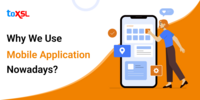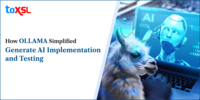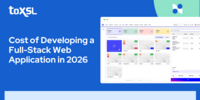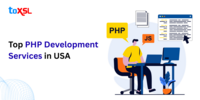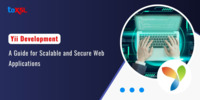- Nov 19, 2025
Share this post on:

Have you ever wondered what the future holds for the internet and web development? How will technologies like Web3, blockchain, and decentralized applications (dApps) reshape the digital landscape we interact with every day? What new opportunities and challenges will arise as control shifts from centralized entities to distributed networks? The Web3 market alone is projected to grow from $4.43 billion in 2024 to $6.15 billion in 2025, with a staggering CAGR of 38.4% expected through 2029.
The future of web development is increasingly rapid with Web3 technologies, an ecosystem built on blockchain that aims to decentralize control, enhance security, and empower users with ownership of their data and digital identities.
Key Takeaways
- Web3 empowers user data ownership through decentralization.
- Blockchain provides security, immutability, and transparency.
- DApps reduce intermediaries, increasing privacy and trust.
- Web3 market expected to exceed $81.5 billion by 2030.
Understanding Web3, Blockchain, and Decentralized Apps
What is Web3?
Web3 refers to the third generation of the internet, where decentralization, user sovereignty, and blockchain technology form the backbone. Instead of relying on central servers or authorities, Web3 distributes power across connected nodes, reducing single points of failure and enabling trustless interactions secured by cryptography and consensus mechanisms.
Working Process of Web3:
Web3 describes the next iteration of the internet, combining decentralized blockchain infrastructure with user empowerment.
- Built on decentralized networks of nodes rather than centralized servers.
- Users own their data, identities, and assets via cryptographically secured wallets.
- Smart contracts automatically enforce transaction terms without intermediaries.
- Decentralized storage (e.g., IPFS) hosts data distributedly, enhancing uptime and censorship resistance.
- Enables interoperability across multiple blockchains and platforms.
Benefits of Web3:
Data Ownership & Privacy: Users control their data and decide access.
- Security: Decentralized architecture mitigates central points of failure and hacks.
- Trustless Operations: Smart contracts enable automated, transparent agreements.
- Community Governance: DAOs empower collective decision-making.
- Reduced Costs: Eliminates intermediaries, lowering transaction and overhead expenses.
- Interoperability: Assets and data transfer seamlessly across chains.
- AI & Web3 Synergy: AI-powered decentralized apps improve personalization and efficiency.
Development Cost of Building Web3 Apps: Building a Web3 project typically ranges from $20,000 to $100,000, influenced by blockchain platform choice, smart contract complexity, UI/UX design, integrations, and security protocols.
What is Blockchain technology?
Blockchain is the critical infrastructure enabling Web3. It is a distributed ledger maintained by a network of nodes that records transactions securely and transparently. This eliminates the need for intermediaries, reduces fraud, and empowers users to verify and control their data and assets.
Working Process of Blockchain :
Blockchain is the core technology enabling Web3’s decentralization.
- A distributed ledger records immutable transaction data across peer nodes.
- Consensus algorithms (Proof of Work, Proof of Stake) validate transactions without a central authority.
- Cryptographic hashing secures data integrity.
- Smart contracts enable programmable transactions.
- Once data is written, it cannot be altered uninhibitedly, ensuring traceability.
Benefits of Blockchain:
Enhanced Security & Trust: Immutable records reduce fraud risk.
- Transparency: Public verifiability suits supply chain, finance, and regulatory compliance.
- Decentralization: Removes reliance on intermediaries, reducing bottlenecks.
- Efficient Settlements: Faster transaction processing and cost reductions.
- Tokenization: Supports digital assets and micropayments with low fees.
Development Cost of Building Blockchain Solutions: Blockchain solutions often start around $15,000, depending on infrastructure needs, smart contract auditing, consensus mechanism complexity, and integration requirements.
What are Decentralized applications (dApps)?
Decentralized applications run on blockchain networks and leverage smart contracts, self-executing programs that automatically enforce rules coded within. Unlike traditional applications, dApps do not depend on centralized servers but operate in a distributed fashion, offering greater resilience, transparency, and censorship resistance.
Working Process of dApps:
DApps are applications running on decentralized networks rather than centralized servers.
- Backend logic runs on blockchain nodes.
- Open-source and community-verifiable code.
- User transactions are validated by network consensus.
- Data is stored on decentralized storage platforms.
- Interaction through blockchain wallets with private keys.
Benefits of dApps:
- Resilience: No central point of failure; censorship-resistant.
- Privacy: Users retain control over identity and data.
- Transparency: Open smart contract operations enhance trust.
- Lower Costs: Reduces intermediaries and operational expenses.
- Incentivization: Token economies encourage user engagement.
Development Cost of Building dApps: Developing decentralized applications can cost between $20,000 - $100,000, depending on blockchain choice, feature set, smart contract complexity, and frontend design.
Why Does This Matter for Web Development?
Web development in the Web3 era goes beyond creating interactive websites. It involves programming blockchain networks, developing smart contracts, integrating decentralized identity systems, and ensuring interoperability across diverse chains and dApps. Web3 developers use specialized languages like Solidity for Ethereum or Rust for Solana, and they focus on features such as trustless transactions, data privacy, and user-controlled assets.
This transformation affects both developers and users:
- Developers must adapt to new decentralized paradigms and tools, mastering blockchain protocols, smart contract security, and cryptocurrency integration.
- Users gain ownership of their data and assets, interact directly without intermediaries, and participate in decentralized governance models like DAOs (Decentralized Autonomous Organizations)
Key Trends Shaping the Future of Web3 and Decentralized Development
The future of Web3 and decentralized development is being shaped by several transformative trends that are driving innovation, adoption, and integration across industries globally. Here are the key trends defining the future of Web3 and decentralized development:
Decentralized Finance (DeFi) Expansion:
DeFi platforms are revolutionizing financial services by enabling lending, borrowing, staking, and yield farming on permissionless blockchain networks. In 2025 and beyond, DeFi is expected to mature with enhanced security, better regulatory clarity, and institutional adoption, making decentralized finance a core Web3 component.
Mainstream Adoption of dApps:
Decentralized applications are moving into mainstream use cases beyond finance, including gaming, social media, supply chain management, and digital identity. The improved user experience and interoperability solutions will accelerate dApp adoption and usability.
Interoperability Between Blockchains:
Seamless interaction between different blockchain networks is critical for the growth of the Web3 ecosystem. Cross-chain bridges, unified standards, and interoperability protocols enable users to transfer assets and information securely across diverse platforms without centralized intermediaries, extending into specialized applications like blockchain recruiting.
Enhanced Data Privacy and Ownership:
Web3 empowers users to fully own and control their data using decentralized identity systems and encrypted storage. This shift challenges traditional data monetization models and promotes privacy-first innovations, supporting user autonomy on the internet.
Integration of AI and Machine Learning with Web3:
Combining AI/ML with decentralized networks unlocks new possibilities like decentralized prediction markets, advanced automated smart contracts, and personalized but privacy-preserving applications. This intersection is poised to enhance Web3’s intelligence and adaptability.
Challenges and Considerations
While Web3 and blockchain hold tremendous promise, the path forward also involves notable obstacles - scalability and transaction speed issues, complex user interfaces, evolving regulatory landscapes, and the need for robust security to prevent exploits in smart contracts and platforms. Developers and stakeholders must address these alongside education and infrastructure development to realize Web3’s full potential.
The future of website development is rooted in the decentralized promise of Web3 and blockchain, offering a more democratized, secure, and user-centric internet. As these technologies mature, they will redefine how we build, interact with, and govern digital platforms across industries and communities.
Conclusion:
At ToXSL Technologies, we see a future where Web3, blockchain, and decentralized applications reshape the digital landscape. These cutting-edge technologies enable businesses and users to achieve security, transparency, and control over data and digital assets.
With our custom Web3 development solutions, your business can embrace the decentralized future, achieving innovative, cost-effective, and scalable digital experiences. Contact us for more information.
FAQ's
1. How will Web3 transform the future of web development?
Web3 will transform web development by enabling decentralized, user-controlled experiences. Developers will focus on smart contracts, tokenized economies, and blockchain integration, moving away from centralized platforms to deliver transparency, security, and greater ownership for users.
2. How are decentralized apps different from traditional apps?
Decentralized apps (dApps) operate on blockchain networks instead of centralized servers. They run via smart contracts, ensuring transparency, censorship resistance, and security, while traditional apps rely on centralized authorities controlling data and backend infrastructure.
3. What programming languages are essential for Web3 and blockchain development?
Developers must learn Solidity, Rust, Vyper, and JavaScript frameworks like Web3.js and ethers.js. These languages power smart contracts, blockchain interactions, and dApp functionality, making them core skills for building future-ready decentralized applications.
4. What role do NFTs play in shaping Web3 applications?
NFTs bring unique ownership to digital assets, from art and collectibles to gaming items and identity credentials. They empower creators, drive new revenue streams, and fuel innovation in decentralized marketplaces and community-driven ecosystems.
5. How will interoperability shape the future of decentralized apps?
Interoperability will enable dApps and blockchains to communicate seamlessly. It ensures assets, data, and tokens move across platforms without restrictions, fostering a more connected, efficient, and user-friendly decentralized ecosystem in Web3.




